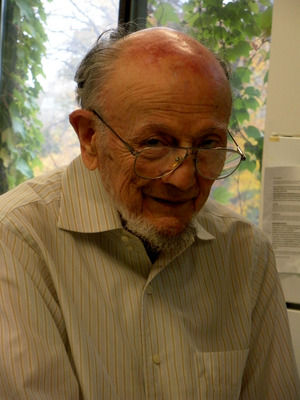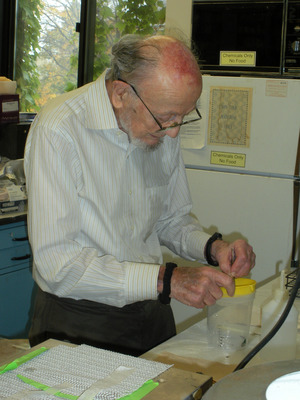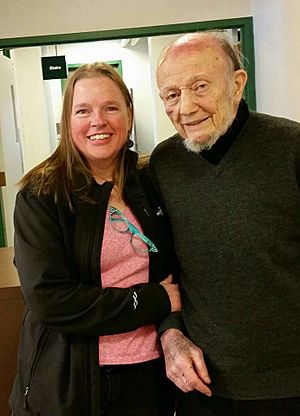André Jagendorf facts for kids
Quick facts for kids
André Jagendorf
|
|
|---|---|
 |
|
| Born |
André Tridon Jagendorf
October 21, 1926 |
| Died | March 13, 2017 (aged 90) |
| Nationality | American |
| Citizenship | United States |
| Alma mater | Cornell University, B. S. Plant Physiology, 1948 Yale University, Ph.D. Biophysics, 1951 UCLA, Post Doc. 1951-1953 |
| Known for | Plant Physiology, Plant Biochemistry, Chemiosmosis |
| Awards | United States National Academy of Sciences member (1980) Co-recipient of 2012 Lifetime Achievement Award of The Rebeiz Foundation of Basic Biological Research |
| Scientific career | |
| Fields | Biochemistry, Plant Physiology |
| Institutions | Johns Hopkins University (1953-1966) Cornell University |
André Tridon Jagendorf (October 21, 1926 – March 13, 2017) was an American scientist. He was a professor at Cornell University. He is famous for his important discovery about how plants make energy. He showed that tiny parts of plant cells, called chloroplasts, create a special energy molecule called adenosine triphosphate (ATP). He proved they do this using a process called chemiosmosis, which was an idea from another scientist, Peter Mitchell.
Contents
About André Jagendorf
André Tridon Jagendorf was born in New York City on October 21, 1926. His parents were Moritz Adolph and Sophie Sheba Jagendorf. He married Jean Elizabeth Whitenack in 1952. They had three children: Suzanne, Judith, and Daniel. He also had 8 grandchildren and 9 great-grandchildren. André Jagendorf passed away on March 13, 2017.
His Education and Career
André Jagendorf went to Cornell University for his first degree. There, a teacher named Loren Petry greatly influenced him. He then earned his PhD in 1951 from Yale University. After that, he went to UCLA for more research. He called his time at UCLA "the happiest years of my life."
In 1953, Jagendorf became a professor at Johns Hopkins University. He worked there for many years. Later, he returned to Cornell University as a professor of Plant Physiology. In 1981, he became the Liberty Hyde Bailey Professor. Even after 1997, when he became a professor emeritus (retired but still involved), he continued his research. He also helped guide young scientists until just before he died.
His Important Research
André Jagendorf's most famous work was about how chloroplasts make ATP. ATP is like the energy currency that cells use to do work.
The Chemiosmotic Idea
He first heard about the idea of chemiosmosis from Peter Mitchell. At first, Jagendorf thought Mitchell's idea was strange. But his colleague, Geoffrey Hind, read Mitchell's paper and thought it might explain something they were studying. This made Jagendorf curious.
He started talking with Peter Mitchell. Mitchell invited him to visit his lab to learn more about the chemiosmotic idea.
The Key Experiment
Later that summer, Jagendorf did a very important experiment. He showed that making ATP in chloroplasts depended on how much the pH (a measure of acidity) was different inside and outside a part of the chloroplast called the thylakoid membrane.
Here's how his experiment worked:
- He put chloroplasts in a very acidic liquid (pH 4) for a short time in the dark.
- Then, he quickly moved them to a less acidic liquid (pH 8) that also had the ingredients needed to make ATP (ADP and Pi).
- When the chloroplasts moved, the inside of the thylakoid stayed acidic (pH 4), but the outside became less acidic (pH 8). This created a big pH difference.
- Right away, the chloroplasts started making a lot of ATP!
This experiment showed that the difference in pH (like a proton "force") was what drove the making of ATP. It was one of the first clear proofs for Peter Mitchell's chemiosmotic idea. After Jagendorf's results, Mitchell became more confident in his own theory.
Jagendorf also did pioneering work in other areas of chloroplast biology, like how they fix their own DNA.
Awards and Recognition
André Jagendorf received many honors for his work:
- He became the President of the American Society of Plant Physiologists in 1967.
- He received the Charles F. Kettering Award in 1978.
- In 1980, he was elected to the National Academy of Sciences. This is a very high honor for scientists in the United States.
- He received the Charles Reid Barnes Life Membership Award in 1989.
- In 2012, he received the Rebeiz Foundation for Basic Research Life Time Achievement Award. This award recognized his contributions to understanding how ATP is made.
At the award ceremony, other scientists praised his work. Tom Sharkey said that Jagendorf was a "brilliant and original scientist." He noted that Jagendorf's findings helped establish how photophosphorylation (making ATP using light) works. His acid-to-base experiment was revolutionary. It helped confirm the chemiosmotic theory, which changed how scientists understood energy production in cells.
Jagendorf is also recognized as a Pioneer Member of the American Society of Plant Biologists.
Podcasts
On September 8, 2016, André Jagendorf talked about his life and career with his colleague, Robert Turgeon, in a podcast.
Images for kids






